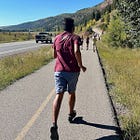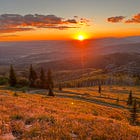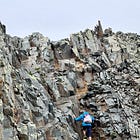Welcome back, and thanks to the many readers who sent messages of encouragement after last week’s post, where I revealed a big-project desire and dream to develop in the new year. This week, the newsletter shifts from a personal deep-dive to a more practical collection of running advice and links.

Make an Annual Training Plan
Two weeks ago, I wrote about how to choose your “A” race or main goal for the year, and then how to choose and calendar other races around it. My main event will be the Grand to Grand Ultra weeklong self-supported 170-mile race in September, but I’ve also got a 100K earlier in the year. Now, how do I plan to train for them?
I could use the TrainingPeaks online tool to create an Annual Training Plan (ATP), which builds training blocks and plugs in recovery weeks by taking into account the events you input. But as much as I love TrainingPeaks and have used it as my personal training log and coaching platform for over a decade, I find their ATP builder overly rigid and clunky, not in synch enough with my real life. I prefer scrutinizing our family calendar and outlining the year with seasonal training blocks the old-fashioned way, on a Microsoft Word doc that I print and keep on my desk.
I’ll demonstrate for you how I’m outlining my 2024 plan—which is a work in progress—in the hope it helps you do the same to structure your training, build motivation, and reach your athletic goals in the new year.
(If this nerdy planning exercise makes your eyes glaze over, please skip to the bottom half for some favorite links.)
Some basic principles
Training volume, aka “load,” should wax and wane, or build and recover, around a small number of macrocycles (training blocks) during the calendar year. This idea is based on the tried-and-true concept of periodization, which leads to athletic gains by stressing the body with a progressive training load, then allowing it to recover through reduced training and rest. This cycle leads to adaptation and improvement, and also helps prevent burnout and injury. For example, a runner training for a marathon in the spring and in the fall could structure their annual plan around two macrocycles. More experienced runners might be able to handle four macrocycles and divide the year roughly into quarters, each building up with high volume to a big goal.
The closer you get to your main goal race, which should be toward the end of a macrocycle, the more specific your training should be for the particular challenges of that event. Earlier in the cycle is the best time to work more generally on cardiovascular fitness with high-intensity speedwork, especially if you’re training for ultras. (If your goal is a PR at a shorter race, however, then you should work on high-intensity speedwork throughout the cycle, but get increasingly specific with practicing your pace for the race-day effort).
Each block should have “mesocycles” lasting three to five weeks with a specific purpose or focus during that meso block (e.g. speedwork for cardio fitness and pace practice; steady medium-length and long runs for endurance; heat training and/or increased vert to prep specifically for a hot and/or hilly ultra; tapering pre-race).
Each mesocycle is further broken down to microcycles, typically lasting a week, and I believe most mesocycles should end with a “cutback week” with reduced training for increased rest/recovery.
This is a good guide if you want the nitty-gritty on these cycles. I’m going to focus here on (1) outlining macrocycles and (2) starting to plan the mesocycles. I’ll leave it to you to figure out how to design your training for specific weeks (my book has lots of guidance on how to make your own week-by-week plans!).
Start by plugging in your race goals and your major real-life events
I chose a handful of key races for 2024, as described in that post two weeks ago. Now, I have to also take into consideration other major events that will affect training—such as a weeklong retreat and college graduation in May; a wedding with travel in June—and plan around them. I will make these life-event weeks cutback weeks and take the pressure off myself to maintain long runs and high volume during those weeks. Ask yourself, do you have any major family or work trips planned, or crunch periods at work, or a back-to-school season for your kids when you’ll be stretched thin? If so, make those weeks lighter-volume cutback weeks.
Take the climate and weather where you live into consideration. Ask yourself if you truly want or realistically can handle high-volume peak training during extremely hot summers or wet or snowy winters.
In advance of your most challenging “A” goal race, schedule your most depleting mesocycle to be six to eight weeks prior. In other words, “get your training in the bank” and be in peak shape six weeks ahead of the goal race. Then have a cutback week for recovery, followed by two more weeks of solid but not overly depleting training to sharpen your fitness, then taper. Too many training plans (especially generic marathon or 50K plans) make the mistake of building up to the most depleting week, with the longest long run, right before two (maybe three) taper weeks, which risks getting you to the start line managing injury and fatigue rather than having fresh legs.
Give yourself at least one “off period” in the year of at least two to four weeks to be unstructured. Cut back or eliminate your long runs during this break; run by feel and for fun; and/or incorporate more cross-training. I typically do this for a few weeks following a major effort such as a 100-miler as well as between Thanksgiving and Christmas.
My three macrocycles for 2024
January - mid-May (20 weeks): Focus on speed + endurance, building to a spring 100K, then recover.
mid-May - September (19 weeks): Focus on mountain skills + strength + endurance for a mountain 100K and specific training (e.g. heat adaptation, carrying a pack, sand running) for the Grand to Grand Ultra.
October - December (13 weeks): Maintenance mode and off season. After recovering for a couple of weeks from the Grand to Grand, I’ll shift training to “maintenance” which means consistent running but lower mileage and more strength/mobility work and cross-training. Weekend long runs become medium-length, and I may run only four or five times a week instead of six. I’m open to the possibility of jumping into a late-year ultra during this block for Type 2 fun and to explore a new area (maybe Hellgate 100K back East in early December?), but I wouldn’t train too hard or too specifically for it; I’d leverage my fitness from the prior 10 months and wing it, then take more time off around Christmas.
Now let’s look at how the first macrocycle breaks down. I’ll save the second one—which includes training for Never Summer 100K in late July and then peak training for the Grand to Grand during July through August—for a post later this spring.
Macrocycle 1 January - Mid May:
My main goal is to train for the Leona Divide 100K near Los Angeles on April 20 (a Western States qualifier). I scheduled two races in February and March mainly as supported long training runs for this longer-term 100K goal.
I’ll start with building endurance and practicing specific skills for the Running Up for Air 12-Hour hill-climb timed ultra near Salt Lake City on February 3 (something I’m starting to do now in late December). This event features repeat laps hiking up 2.9 miles and running back down a snow-covered mountain, with about 2600 feet of elevation gain each lap. I’ll emphasize long run/hikes with steep climbs, much of it on snow, and incline treadmill workouts with power-hiking on a steep uphill (endeavoring to cultivate patience at that slower pace). I’ll grow my peak long runs in early January to at least 6 hours, half the duration of the 12-hour event (ideally I would go longer to 8 hours, but I don’t have a long-enough training horizon to jump to that duration).
January and February’s mesocycles also need to prepare me for the challenges of Moab Run the Rocks, a three-day stage race March 8 - 10 with every day featuring a half- to full-marathon distance on fairly runnable high-desert terrain. Therefore, I’ll incorporate weekly speed sessions and steady-effort runs on flatter routes, along with all the hill work. Obviously, the Moab three-day stage race is quite different from the 12-hour snowy-mountain race in early February, but I like the contrasting challenges. Bottom line: my choice of the very different February race only five weeks before the March race will compromise my training for the March race—I’d perform better at the March Moab race if I trained specifically for it during January—but I don’t mind the tradeoff. I am doing both races because the destinations and challenges appeal to me, and they work together to develop a variety of skills and endurance that all will be beneficial for the main 100K goal.
My peak training period for the April 100K will be complicated by an eight-day family trip abroad March 22 - 30. Therefore I need to push myself to have a high-volume week immediately following the Moab stage race (rather than taking a recovery week after that race, as I otherwise would), and complete the high-volume peak training for the 100K before the family trip. The family trip will serve as a cutback recovery week; then I’ll have one more week in early April of solid but lower-volume training, then taper for two weeks.
The three weeks following the April 20 100K include a weeklong writers’ retreat followed by travel to my son’s college graduation. I will run minimally during these three weeks to fully recover from the 100K race in advance of Cycle 2’s summer training for the Never Summer 100K and Grand to Grand Ultra.
With that outline, I can sit down on a Sunday and plan the coming week’s training with more purpose and understanding of how a single training week fits into the bigger picture.
If you’re curious about my “A” goal and what goes into preparing for it, I hope you’ll watch or listen to this new 40-minute podcast! I had a fun time being interviewed about the unique, extreme challenges of the Grand to Grand Ultra and why I’m so excited to return to it in September. (Here is the audio version if you prefer an audio podcast to YouTube.)
Newsletter highlights from 2023
My subscriber base doubled during the past year (thanks to you!), with most of the growth occurring during the past six months. I am thrilled to have so many new readers here. But, that means that many readers missed posts from earlier this year.
Below, I highlight seven favorites. I hope they interest you to click through and read.
Most popular: These two stories are the most popular from the year in terms of readership and shares. Both feature stories of underdogs and teamwork.
Race reports: These two examples of race recaps I wrote in 2023 capture the journey of an ultra with its pain, self-doubt, and fulfillment. The first one has practical advice about pain management, too.
Adventure: This story, which includes some of my favorite photos from the year, is about working through fear but also respecting it while summiting a mountain.
Community: This is a story about overcoming intimidation to show up and take part in something bigger, and finding support and meaning as a result.
Humor: This is just a fun, silly, short post.
Finally, I love hosting a monthly online meetup with the paid subscriber group. Only a fraction of the members log on (I record the session and send the link to others so others can listen to it later), but the small size of the group creates great conversation. We take turns sharing experiences and advice related to running, aging, wellness, and mundane stuff. It’s the core of this newsletter community. If you’d like to take part, then please upgrade your subscription to the supporter level. The next one will be Wednesday, January 17, at 5 p.m. Mountain.
Happy Solstice and holidays to you all! I hope you have a special, peaceful, healthy week of celebration.
If you’d like to support my writing but would rather not commit to a paid subscription, please consider a small donation to this virtual tip jar.












Awesome post and info.... I’m still a little behind on my reading. Next long run that podcast will keep me company.
Good luck at Never Summer! I ran the 60k this past season as part of the mini slam and this year will attempt the 100k as part of the full slam (and my longest run to date). I'm looking forward to seeing the Ruby Jewel side of the course that I didn't get to see in the shorter offering. Don't know if you've run that race before but it's a special one :)